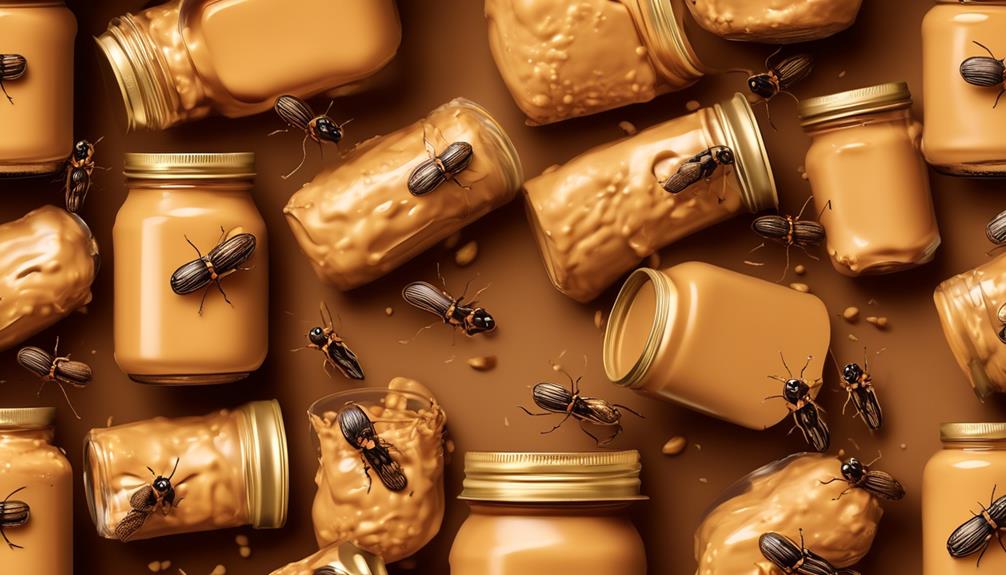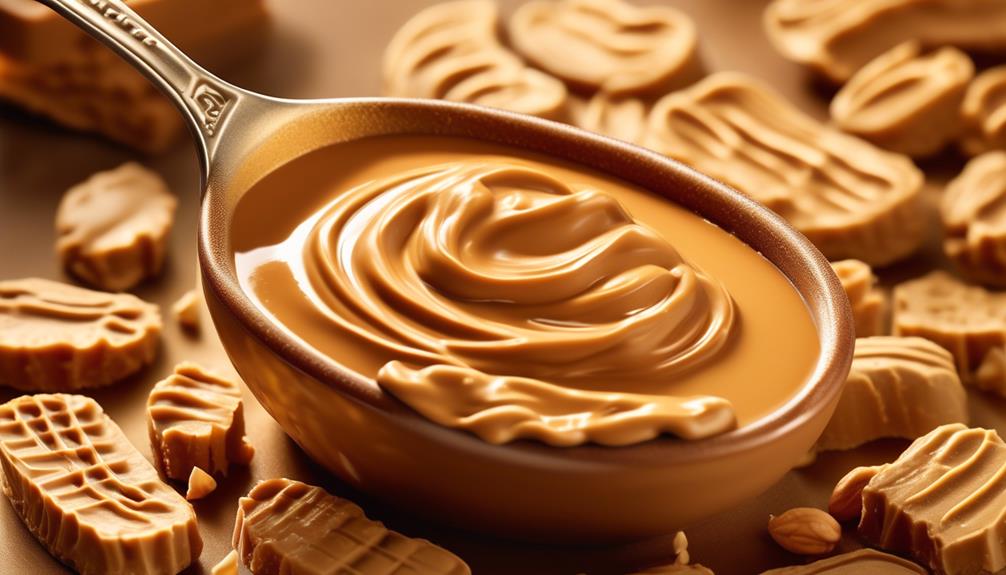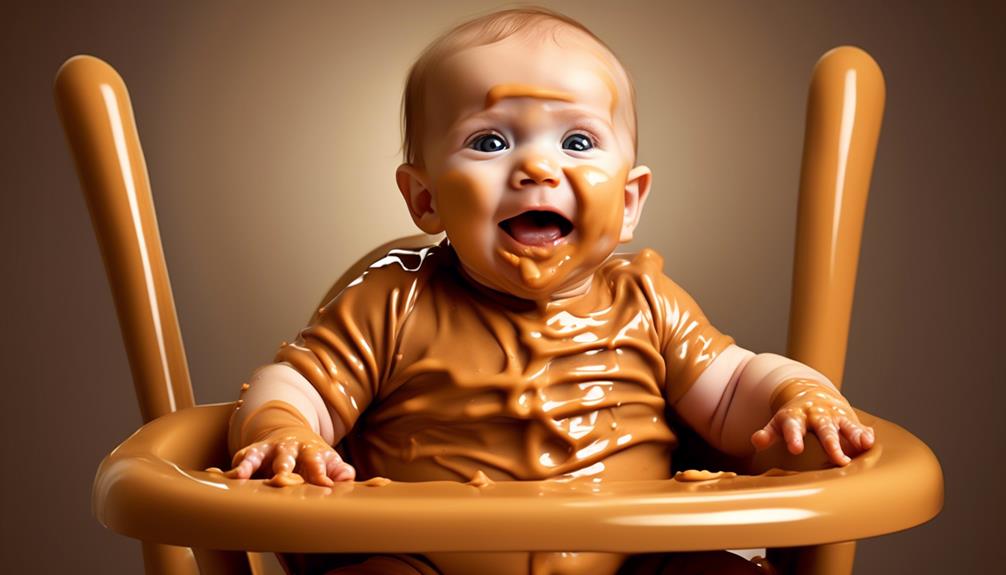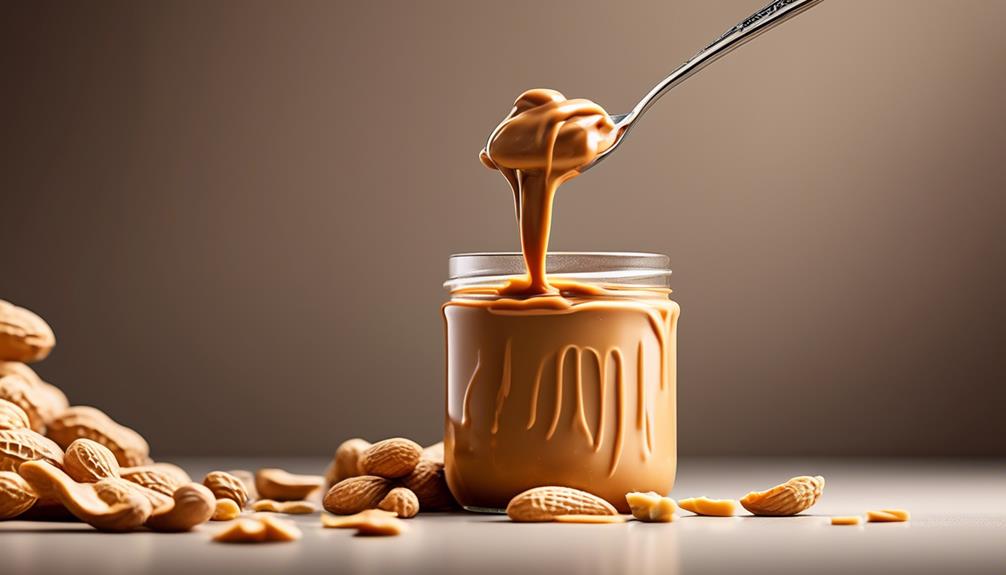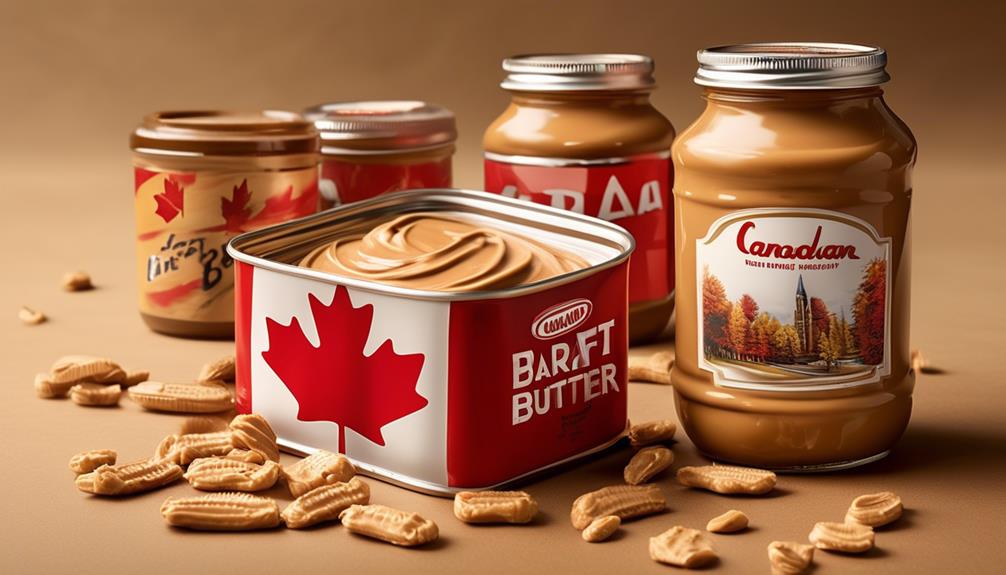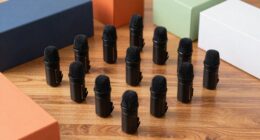Have you ever pondered why there are occasionally bugs in peanut butter? It’s a thought that could give you pause before smearing that delicious spread on your toast.
Well, there's a fascinating explanation behind this phenomenon, and it's not as alarming as it might seem at first. Let's explore the surprising reasons behind the presence of bugs in peanut butter and what it means for the food we consume every day.
Key Takeaways
- Insect fragments and rodent hairs are naturally occurring contaminants in peanut butter.
- The FDA sets limits for these contaminants to protect consumers from health hazards.
- Advanced inspection technologies, visual inspection, and sieving processes are used in quality control measures to eliminate contaminants.
- Consuming peanut butter within regulated limits is generally considered safe, but exceeding the allowed amounts may require additional testing and potential recalls.
Natural Occurrence
In food production, the natural occurrence of insect fragments and other contaminants is a well-documented phenomenon that necessitates careful monitoring and regulation to ensure consumer safety.
When it comes to peanut butter, the presence of bug parts, including insect fragments and even rodent hairs, is a naturally occurring occurrence. The Food and Drug Administration (FDA) sets specific limits for these contaminants in peanut butter and other foods to mitigate any potential health risks.
Manufacturers rely on precise laboratory methods to quantify the amount of filth present in peanut butter and adhere to FDA guidelines for sampling and analysis.
Despite the unsettling nature of bug parts in our food, it's important to note that consuming peanut butter is generally considered safe, as the levels of contaminants are regulated and maintained within safe limits.
This underscores the significance of regulatory measures in food safety to protect consumers from any potential health hazards associated with naturally occurring contaminants in peanut butter and other food products.
Regulatory Limits

The regulatory limits for filth in peanut butter, including insect fragments, rodent hairs, and excrement, are established by the FDA to ensure consumer safety and adherence to food quality standards. These limits are crucial in maintaining the quality and safety of peanut butter products available in the market.
As per FDA regulations, peanut butter can contain up to 30 insect fragments per 100 grams. Additionally, the FDA allows for one rodent hair in every 100 grams of peanut butter. These limits are set to mitigate potential health risks associated with the consumption of filth in food products.
It's important to note that if a food product exceeds the allowed amount of filth, the FDA may require additional sampling and testing to address and rectify the issue. The FDA's Food Defect Levels Handbook provides detailed information on the allowed filth levels in various food products, including peanut butter, serving as a comprehensive guide for manufacturers and regulatory authorities.
These regulatory limits play a critical role in safeguarding the quality and safety of peanut butter consumed by consumers.
Inspection Methods

We use various inspection methods to ensure the quality and safety of peanut butter.
These methods include insect contamination detection and quality control measures.
Insect Contamination Detection
Manufacturers rely on precise lab methods, such as macroanalysis and microanalysis, to accurately quantify insect parts and other contaminants in food products.
When inspecting for insect contamination in peanut butter, we follow FDA guidelines, which set regulations for the maximum allowable amount of insect fragments and rodent hairs. These guidelines also provide instructions for obtaining representative samples for analysis, ensuring accurate inspection of insect contamination.
If excessive insect fragments are found in peanut butter, the FDA may require additional sampling, testing, and potentially a product recall.
The FDA's Food Defect Levels Handbook offers detailed information on the permitted levels of insect filth and other contaminants in various food products, serving as a crucial resource for ensuring the safety and quality of peanut butter and other food products.
Quality Control Measures
How can we ensure the accuracy and precision of our inspection methods for quality control measures in peanut butter production?
Quality control measures for peanut butter production involve rigorous inspection methods to detect and eliminate potential contaminants, such as insect fragments and rodent hairs.
The US Food and Drug Administration (FDA) sets strict guidelines for the allowable levels of these contaminants in food products, as outlined in the FDA's Food Defect Action Levels.
To meet these standards, we employ advanced inspection technologies, including X-ray systems and metal detectors, to detect foreign materials.
Additionally, visual inspection and sieving processes are utilized to ensure the absence of impurities.
Our commitment to implementing these comprehensive quality control measures guarantees the safety and purity of the peanut butter products that we deliver to our consumers.
Sample Collection

During the sample collection process, it's crucial to ensure that proper techniques are employed to obtain representative samples for analysis.
- Random Sampling: When collecting samples of peanut butter, we must ensure that random sampling is conducted to obtain a cross-section of the entire batch. This helps to ensure that any potential bugs, food fragments, or other contaminants aren't overlooked.
- Sample Size: It's imperative to collect an adequate sample size to ensure that any potential contaminants, such as insects or rodent droppings, are accurately represented in the analysis.
- Storage Conditions: Proper storage of the collected samples is essential to maintain the integrity of the peanut butter samples. This includes protecting them from moisture, light, and temperature extremes to prevent any potential degradation or changes in the sample composition.
- Chain of Custody: Maintaining a clear chain of custody is important to ensure the reliability and accuracy of the sample analysis. This involves documenting who collected the sample, where and when it was collected, how it was stored, and who handled it throughout the process.
Ensuring that these sample collection practices are followed meticulously is essential for accurately identifying whether peanut butter products contain insect or rodent contaminants.
Analytical Approaches

After ensuring meticulous sample collection from peanut butter batches, the next step involves employing specific analytical approaches to study and interpret the obtained data and information.
Analytical approaches play a crucial role in identifying and quantifying the presence of food defects such as insect fragments or rodent hairs in peanut butter. Utilizing methods such as microscopy, spectroscopy, and chromatography enables us to accurately detect and analyze these contaminants.
For instance, microscopy allows us to visually examine and characterize the nature and quantity of foreign materials present in the peanut butter, while spectroscopy helps in identifying the chemical composition of these contaminants. Additionally, chromatography aids in separating and quantifying different components present in the sample.
These analytical approaches are in line with the guidelines provided by the FDA's Food Defect Action Levels, which specify the maximum levels of natural or unavoidable defects in foods that present no health hazards.
Consequences of Contamination

Excessive filth in food products, such as peanut butter, can pose health risks to consumers and lead to quality control issues for manufacturers.
The presence of insects and their fragments can result in serious consequences, including additional sampling, testing, product seizure, or recalls as mandated by the FDA.
It's crucial for manufacturers to adhere to strict guidelines and utilize lab methods to ensure the safety and quality of peanut butter and other food products.
Health Risks
Consuming food contaminated with excessive filth, such as insect fragments and rodent hairs, poses significant health risks, including the potential for foodborne illnesses such as salmonella and listeria. These health risks are particularly concerning in the case of peanut butter, where the presence of even small amounts of contaminants can have severe consequences.
When the contamination level exceeds the FDA-permitted fragments per 100 grams, the following health risks become prominent:
- Increased susceptibility to foodborne illnesses such as salmonella and listeria.
- Long-term health issues such as digestive problems and compromised immune function.
- FDA-issued recalls impacting consumer trust and brand reputation.
- Potential legal actions, fines, and closure of food manufacturing facilities due to extreme and consistent contamination levels.
It's vital to be aware of these health risks and advocate for stringent quality control measures in peanut butter and other food products.
Quality Control
To ensure the safety and quality of food products, stringent quality control measures must be implemented to prevent contamination and uphold consumer trust.
In the case of peanut butter, the presence of insect fragments and rodent hairs is strictly regulated by the FDA. Manufacturers must adhere to these strict guidelines, as excessive filth in peanut butter can lead to FDA-required sampling, potential product seizure, and recalls.
The FDA sets specific thresholds for different products, including peanut butter, and provides guidelines for obtaining representative samples for analysis. Exceeding the allowed limits of filth can result in legal actions, financial penalties, and damage to brand reputation.
Therefore, regular monitoring and adherence to FDA regulations are crucial to prevent excessive filth in peanut butter and maintain consumer trust in food safety.
Peanut Butter Comparison

Comparing the filth levels in peanut butter to those in other food products reveals the relatively lower action level for insect fragments allowed by the FDA. When we consider the presence of bugs in peanut butter in comparison to other foods, we find that peanut butter is subject to stricter guidelines.
Here's a quick comparison:
- Peanut Butter vs. Spices: Peanut butter allows up to 30 insect fragments per 100 grams, whereas ground oregano can contain up to 125 insect fragments per gram.
- Manufacturing Methods: Manufacturers rely on macroanalysis and microanalysis to determine the amount of filth in peanut butter, as inspecting every bit of the product isn't feasible.
- Regulatory Limits: The FDA sets limits for insect fragments and rodent hairs in peanut butter to ensure safety, allowing one rodent hair per 100 grams of peanut butter.
- Safety: Despite the presence of insect fragments, consuming peanut butter is considered safe, as it adheres to FDA guidelines.
Insects in Peanut Butter Cookies

In peanut butter cookies, the presence of insect fragments from the peanut butter and flour aligns with FDA guidelines for filth levels in food products. When consuming peanut butter cookies, it's important to recognize that the FDA allows for a certain level of insect fragments in food, including peanut butter, to ensure safety and quality.
In a batch of JIF Irresistible Peanut Butter Cookies, the average of 10.33 insect fragments from peanut butter and 315 insect fragments from flour falls within the FDA thresholds. These levels are determined using lab methods such as macroanalysis and microanalysis, as it's impractical to inspect every bit of peanut butter and flour.
While the idea of consuming insect fragments may be off-putting, it's worth noting that the FDA considers it safe to eat peanut butter and peanut butter cookies containing a certain amount of insect fragments. In some cultures, insects provide a source of protein and nutrients. Ultimately, the presence of insect fragments in peanut butter cookies falls within the acceptable limits set by food regulatory agencies, ensuring that the cookies are safe for consumption.
Preventive Measures

Examining the presence of insect fragments in peanut butter cookies allows us to consider preventive measures for maintaining the quality and safety of the product. It's essential to implement rigorous measures to minimize the risk of contamination and ensure the integrity of peanut butter products. Here are some key preventive measures:
- Quality Control Procedures: Regular inspections and quality control measures should be in place throughout the production process to detect and eliminate any presence of insect fragments or other food defects in the peanut butter.
- Proper Storage and Handling: Adequate storage conditions, such as temperature and humidity control, should be maintained to prevent the infestation of insects and minimize the risk of contamination. Additionally, proper handling practices should be enforced to reduce the chances of introducing contaminants during the manufacturing process.
- Effective Pest Control: Implementing stringent pest control measures is crucial to prevent insects and rodents from accessing the production area. Regular pest monitoring and the use of appropriate pest control methods are essential for maintaining a pest-free environment.
- Supplier Quality Assurance: Establishing strict quality standards for raw materials and ingredients, including peanuts, is essential. Suppliers should adhere to stringent guidelines to ensure the absence of contaminants such as insect fragments and rodent hairs in the raw materials used for peanut butter production.
Frequently Asked Questions
Does All Peanut Butter Have Bugs in It?
Yes, all peanut butter may contain bugs, as the FDA allows up to 30 insect fragments per 100 grams. Manufacturers use lab methods to determine filth levels, as it's impossible to inspect every bit.
Consuming peanut butter with bug fragments is safe, and insects provide protein. The presence of filth beyond allowed limits can have serious consequences for manufacturers.
This information ensures the safety and quality of peanut butter products for consumers.
What Bugs Are Not Safe to Eat?
Some bugs aren't safe to eat due to potential toxins or allergens.
Insects like blister beetles or certain caterpillars can contain harmful compounds.
It's crucial to be cautious when consuming insects, as not all are suitable for human consumption.
Always ensure that the bugs you're eating are from a safe and reliable source, and if you have any doubts, consult with a professional to avoid any potential health risks.
Does UK Peanut Butter Have Bugs?
Yes, UK peanut butter may have bugs in it due to the natural presence of insect fragments in agricultural products.
Our food safety regulations allow for a certain level of insect contamination in peanut butter, which is considered safe for consumption.
However, the presence of bugs in peanut butter isn't unique to the UK and is a common occurrence in peanut butter production worldwide.
What Is Peanut Butter Made Of?
We make peanut butter by grinding up peanuts and adding supplements like salt, emulsifying agents, or sugars for flavor.
The FDA allows a certain amount of filth, including insect fragments, in peanut butter, and manufacturers use lab methods to test for this.
Despite the presence of insect fragments, peanut butter is safe to eat, and the FDA strictly enforces guidelines to ensure the safety of our food.
Conclusion
In conclusion, while it may be unsettling to know that peanut butter can contain insect fragments, it's important to remember that this is a natural occurrence and doesn't pose any health risks.
The strict regulatory limits and inspection methods in place ensure the safety and quality of the peanut butter we consume.
It's a coincidence that these bugs are present, but rest assured, they're harmless and don't affect the overall enjoyment of peanut butter products.
